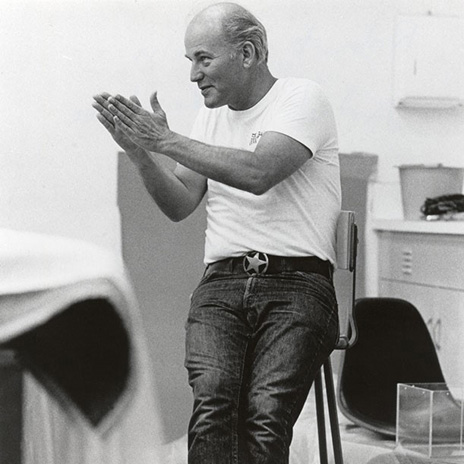Robert
Irwin
(Long Beach, CA, 1928)
For more than thirty years, Robert Irwin has been one of the most influential artists working in America, both as a practitioner and a theoretician. He began his career as an abstract expressionist and moved through successive shifts in style and sensibility until he reached a new aesthetic research focused on perceptual phenomena, such as light, volume and scale.
In the years following his art school training in Los Angeles, at the Otis Art Institute and the Chouinard Art Institute, Irwin joined the Ferus Gallery, a vibrant hub for young artists and collectors that soon became a driving force behind the blossoming of art in Los Angeles during the '60s.
In the early 1960s he began a continuous series of experiments regarding the role of art as 'conditional'—something that works in and responds to the specific experience of the surroundings. Irwin became a pioneer of the LA-based 'Light and Space' movement and a central figure of Conditional Art. Like Minimal artists, he broke with figuration, searching for a new way to make the work of art autonomous in content. He sought to heighten and alter the viewer's awareness of a space using light, nylon scrim sheets, and other unobtrusive structural components.
With this approach, which has enabled the artist to incorporate landscape design and architecture in his practice, Irwin has produced some of the most extraordinary site-conditional projects of recent decades, including Scrim Veil—Black Rectangle—Natural Light at the Whitney Museum (1977); the architecture and grounds of Dia:Beacon (completed in 2003); and the lush Central Garden for the Getty Center in Los Angeles (completed in 1997).
The first encounter between Irwin and Giuseppe Panza di Biumo was in the late '60s at the Pace Gallery in New York. The two immediately embarked on an intense collaboration that culminated in the commission of the three site-conditioned works: Varese Portal Room, Window Room and Varese Varese Scrim (1973) for Villa Panza in Varese. With the help of Irwin, Panza was introduced to the other California-based artists whose research fell within his definition of Environmental Art, among them the young James Turrell.
Irwin's outdoor works direct the spectators' perceptual experience of the loci, making them confront the conditions and qualities of the site. The artist coined four terms to define the relation of a work of art to its setting: site-dominated, site-adjusted, site-specific, site-conditioned.
Robert Irwin has been lecturing in the art, architecture, philosophy, and perceptual psychology departments of numerous universities and, since the '60s, his teachings have had an immeasurable impact on his peers and on the younger generations of artists.
Robert Irwin's work is in numerous public collections worldwide, including the Centre Georges Pompidou, Paris; The J. Paul Getty Museum, Los Angeles; Hirshhorn Museum and Sculpture Garden, Smithsonian Institution, Washington, D.C.; Los Angeles County Museum of Art; The Metropolitan Museum of Art, New York; Museo Nacional Centro de Arte Reina Sofia, Madrid, Spain; The Museum of Modern Art, New York; Solomon R. Guggenheim Museum, New York; and the Whitney Museum of American Art, New York.


















